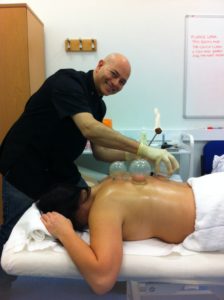The Rio Olympics are on, and there’s nothing better than watching your favorite athletes competing at the highest level in the world. Each and every competitor has trained to the fullest and is hoping to be in the best shape possible, and every one of them will do what they can to stay that way. You’ve seen athletes wearing colorful tape to support their muscles, wearing braces on weak joints, and using massage to speed their recovery between events.
 This year at Rio, it seems like we’re seeing something new, which is a number of athletes that are covered with big purple circles on their backs, legs, and arms. In the pool, Michael Phelps and many of his teammates are sporting these marks. We’ve seen them on a number of the gymnasts and are likely to see them on our track and field athletes as well. While these marks are something new at the Rio Olympics, in reality those circles come from a healing therapy that is actually quite ancient. It’s called cupping therapy, and here are nine things you should know about it:
This year at Rio, it seems like we’re seeing something new, which is a number of athletes that are covered with big purple circles on their backs, legs, and arms. In the pool, Michael Phelps and many of his teammates are sporting these marks. We’ve seen them on a number of the gymnasts and are likely to see them on our track and field athletes as well. While these marks are something new at the Rio Olympics, in reality those circles come from a healing therapy that is actually quite ancient. It’s called cupping therapy, and here are nine things you should know about it:
1) What is cupping? In the simplest terms, cupping therapy is the application of glass or plastic cups to the skin in which a vacuum has been created. The idea is to promote circulation and speed healing.
2) Cupping is considered one of the mainstays of Chinese medicine, along with acupuncture and Chinese herbal therapy. Its use is thousands of years old, and was practiced not only in China, but also in Egypt, and many countries throughout Asia and the Middle East. Today, cupping can be found in use just about anywhere in the world. While today the cups are made of glass or plastic, in ancient times they were made from bamboo or horn.
3) Originally, a vacuum was created in each cup by lighting a small fire and holding it in the cup until all the oxygen is removed. Then the cup is very quickly placed on the skin, creating strong suction (but no burns!) This is called fire cupping, and many practitioners still perform cupping this way today. A second and newer way to create a vacuum is through a pump and gasket system, in which the cup is placed on the skin and the air is pulled out of the cup.
4) There are a couple of ways to use cupping therapeutically. When the cup is just placed on the skin, it is called dry cupping. If the skin is lanced before or after the cup has been placed, it’s considered to be wet cupping. When a cup is placed on the skin with a small layer of oil or lotion and moved back and forth (say, over a cranky muscle) it’s called sliding cupping.
5) Why do it? The benefits of cupping are many. It helps to move and separate sticky fascia and connective tissue, open the pores, loosen tight muscles, increase circulation, and promote healing.
6) Cupping can be used for a variety of conditions, most notably muscle pain and tightness. It can also help with migraines and respiratory conditions, such as bronchitis or asthma. And from the number of Olympic athletes who are using cupping, we can see that it’s a good way to increase circulation, revive tired muscles, and support healing.
7) Does cupping hurt? Actually, cupping works a bit like a reverse massage. The cups do their work by pulling, where massage is all about pushing. I have found that most of my patients request to be cupped because if feels good—and it works. However, depending on where the cups are placed and how tight the suction is, some people may find that the pulling sensation can be a little intense and uncomfortable.
8) About those purple marks. One of the reasons that cupping is effective is because the strong suction breaks tiny capillaries in the skin, leaving a perfectly round mark that looks like a bruise. This micro trauma causes the body to heal not only the capillaries, but the tissues below. How dark the marks appear depends on the strength of the suction and how congested the area was prior to cupping. Like a bruise, the marks disappear in about a week.
9) What not to do. Cupping should not be performed on pregnant women, people diagnosed with cancer, near a fracture, or directly over a muscle spasm. In addition, cupping in contraindicated in areas over a large blood vessel, ulcer, or a deep vein thrombosis (DVT, a large blood clot).
It’s good to know that our Olympic athletes have something new in their recovery toolbox. All those purple marks look innovative and cutting edge, but the truth is that cupping has been around for a couple of thousand years.



